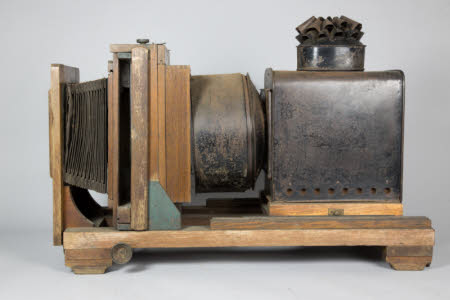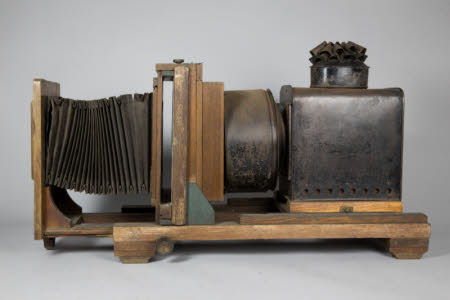Thornton-Pickard photographic enlarging lantern.
Thornton Pickard
Category
Photographic technology
Date
1880 - 1930
Materials
Measurements
450 x 740 x 370 mm
Place of origin
Altrincham
Order this imageCollection
Fox Talbot Museum, Wiltshire
NT 1525168.1
Summary
Thornton-Pickard photographic enlarging lantern. This horizontal enlarger consists of a lamphouse, condenser, negative carrier, bellows and lens. The holder for the paper is separate. They were popular from the 1880s and still available in the 1930s. The lamphouse is a pressed metal box with a domed top and ornately fluted removable chimney. There is a door to the right side witha red glass panel for observing the oil fired illuminant safely. The back door through which the illuminant was introduced is missing as is the oil fired burner. The unit has been updated at some point with a Triumph electric lamp. The lamphouse is set on a solid wooden slide which can be moved using a knurled knob which activates a rack and pinion runner. Attached to the lamphouse is a telescopic pressed metal tube which in turn connects to the box section which holds the main lenses. This enables the lamphouse to be moved to and from the lens assembly. The box section which is fixed to the main frame of the assembly comprises a square backplate with a circular opening with routing around which allows the telescopic extension tube from the lamphouse to securely connect by four small turn buckles. Inside this box, mounted on four metal mounts is a 9 inch convex lens. The front plate of this section also has a circular opening and four further mounts and another 9 inch convex lens. This whole box section assembly is designed to tip back from the next part of the fixed assembly, presumably to allow cleaning/maintenance of the lenses. When back in position the lenses carrier locks into place with two spring clips and posts. The next section is the plate holder which is cleverly mounted to the whole to allow the plate to tipforward or backward by approx five degrees, and the opening which takes the separate plate holder is designed so that the plate holder can be raised relative to the object lens. This is done by means of a knurled knob attached to a rack and pinion. The front of the plate holder assembly has two rails which allow the bellows to slide into place. The front of the bellows attach to the back of the lens board. The lens is mounted on a wooden standard which is adjustable up and down and held by a brass slide and knurled knobbed screw. The lens is attached to the standard with three screws. The base plate appears to be marked for distance in yards. The next ring is the control for an iris diaphragm and marked f6 - f64. The lens board has an ivorine plaque which reads “Thornton –Pickard M.C.C. No 6 Altrincham” and is mounted on rails that allow it to be moved relative to the plate holder assembly. This is achieved by means of a large knurled knob attached to a rack and pinion assembly which allows relative movement of approx. 670 mm
Provenance
Part of the Fenton Collection. A gift from British Film Institute in 2017. From 1986-1999, part of BFI collection for the Museum of the Moving Image. BFI purchased collection in 1986 from James Fenton's Museum of Photography, Port Erin, Isle of Man 1976-1986
Makers and roles
Thornton Pickard , manufacturer

